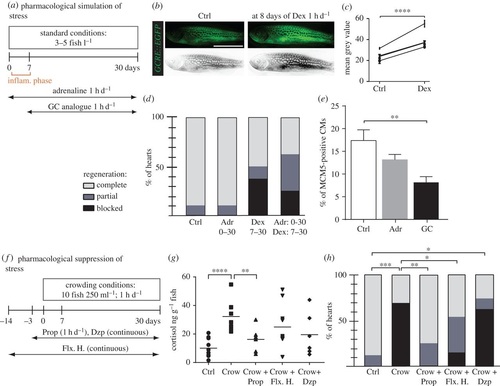Fig. 4
- ID
- ZDB-FIG-160428-12
- Publication
- Sallin et al., 2016 - Acute stress is detrimental to heart regeneration in zebrafish
- Other Figures
- All Figure Page
- Back to All Figure Page
|
Pharmacological simulation of stress reproduces the crowding phenotype, which can be partially rescued by treatment with propranolol and fluoxetine hydrochloride. (a,f) Experimental design. (b) Live Tg(GCRE::EGFP) fish imaged for fluorescence (green converted to grey) before (Ctrl) and after 8 days of 2 mg l-1 dexamethasone (Dex) treatment for 1 h d-1 validates the activity of the drug. (c) Quantification of grey-converted fluorescence shown in (b); N = 4. (d,h) Regenerative scores of AFOG stained hearts at 30 dpci; N ≥ 8. (e) Quantification of MCM5 and DsRed-positive nuclei at 7 dpci in control and after treatments; N ≥ 6. (g) Measurements of whole-body cortisol after single stress exposure in fish with different pretreatment; N ≥ 5. Drugs: glucocorticoid (GC), dexamethasone (Dex, 2 mg l-1, 1 h d-1), adrenaline (Adr, 1 mg l-1, 1 h d-1), hydrocortisone (1 mg l-1), propranolol (Prop, 1 mg l-1, 1 h d-1), fluoxetine hydrochloride (Flx. H., 100 µg l-1, continuous), diazepam (Dzp, 1 mg l-1, continuous treatment). *p < 0.05, **p < 0.01, ***p < 0.001, ****p < 0.0001. (b) Scale bar, 10 mm. |

